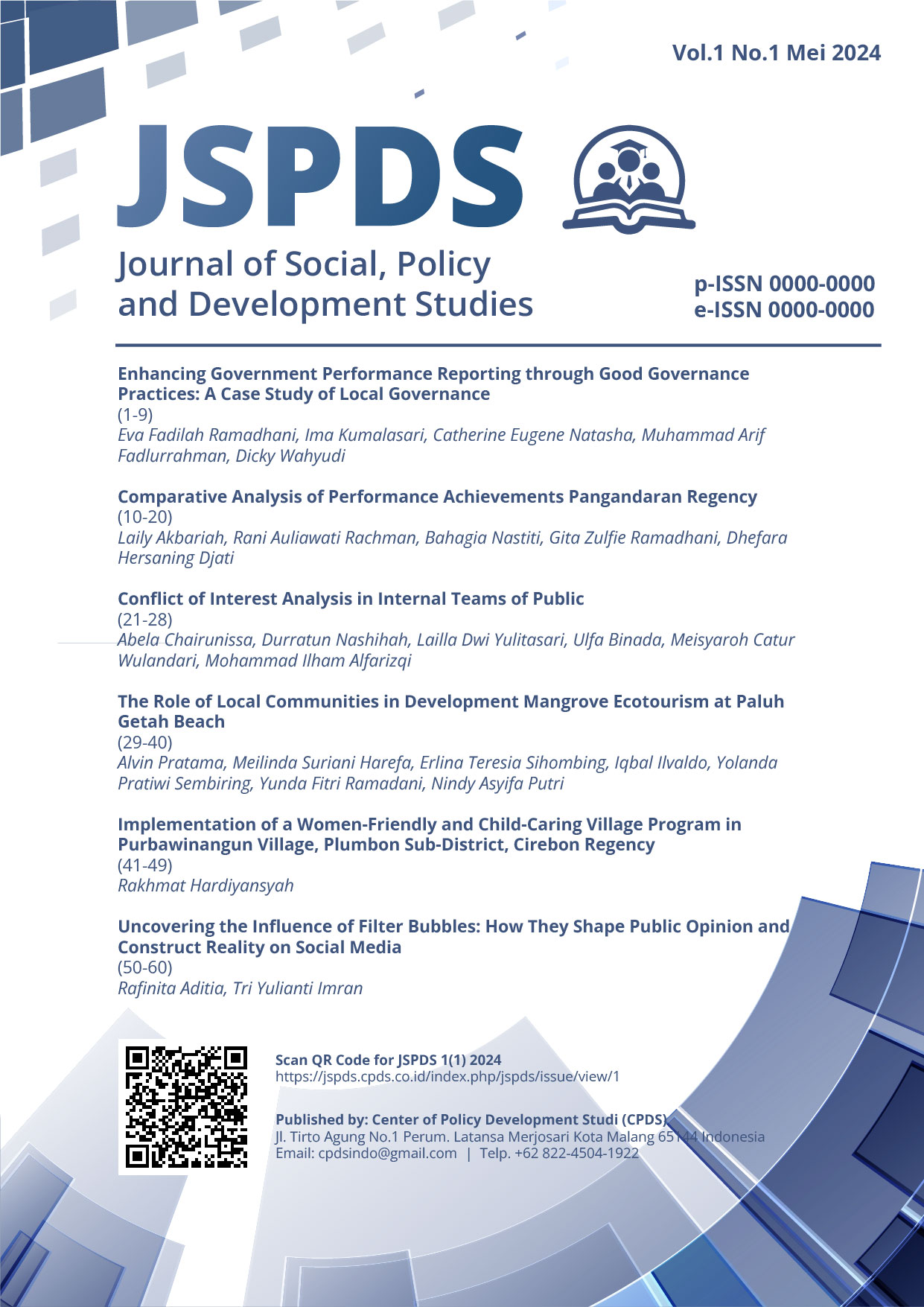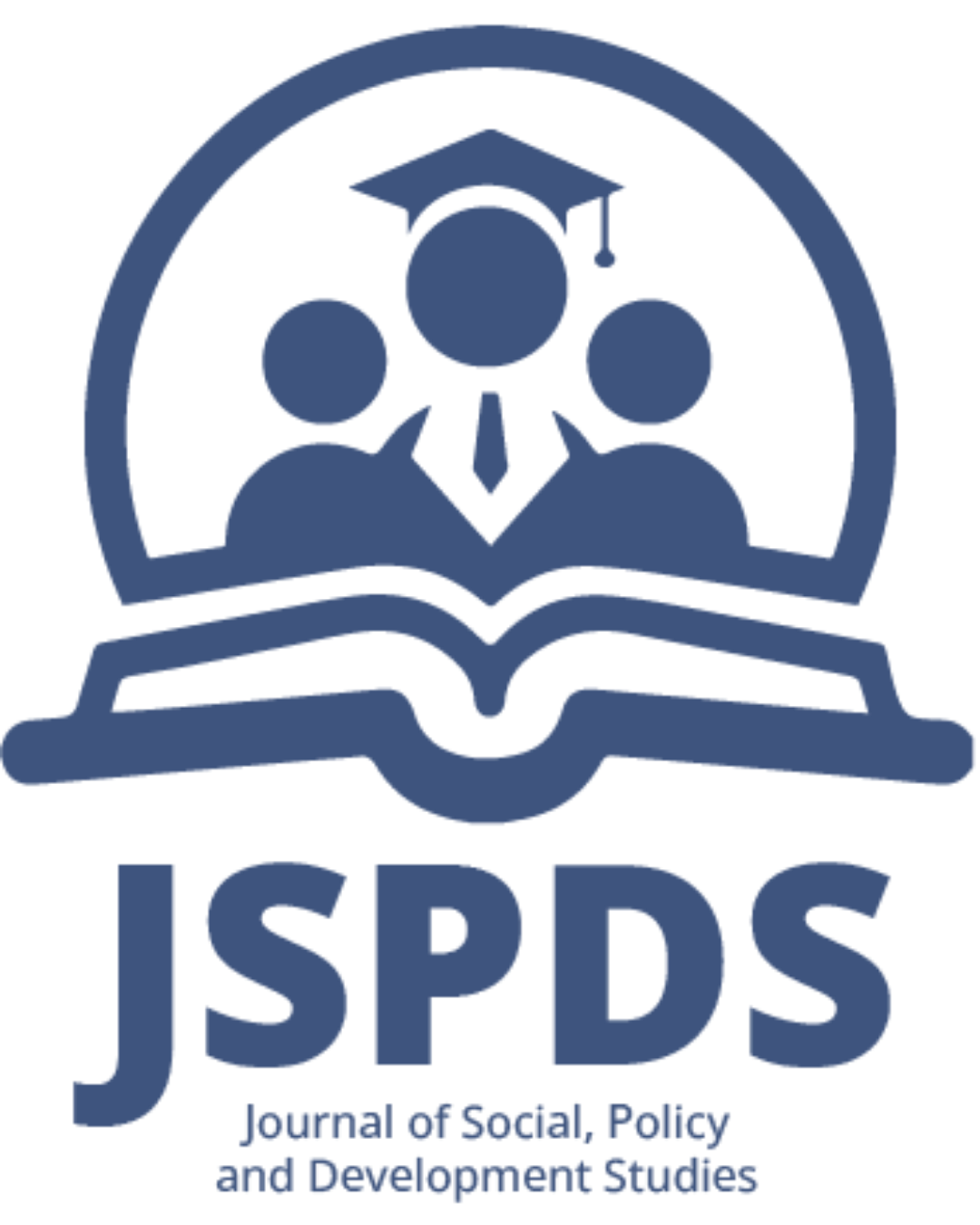Comparative Analysis of Performance Achievements Pangandaran Regency
DOI:
https://doi.org/10.65119/jspds.v1i1.5Abstract
The purpose of the study is to conduct a comparative analysis of Pangandaran Regency's performance achievements in 2020 and 2021, using several indicators presented in the 2021 Government Agency Performance Report. This study was conducted using a quantitative approach. The data used is secondary data obtained from the 2021 Pangandaran Regency Government Agency Performance Report (LKJIP). Analysis using a t-test, where this analysis is used to see the comparison or comparative of work achievements in 2020 and 2021. The results of the analysis show that there is no significant difference between Pangandaran Regency's performance in 2020 and 2021. However, the average performance has increased, indicating an effort to improve. Further analysis is needed to confirm the development of Pangandaran Regency's performance. The results show that although the average performance has increased, there is no significant difference between the two years. This provides a clearer and more valid view of Pangandaran District's performance development and helps in making practical suggestions to address the issues found.
References
Akbar, R., Pilcher, R., & Perrin, B. (2012). Performance measurement in indonesia: the case of local government. Pacific Accounting Review, 24(3), 262-291. https://doi.org/10.1108/01140581211283878
Anindya, E. T., Lestari, H., & Rostyaningsih, D. (2022). Pengaruh Kualitas Pelayanan Dan Harga Terhadap Kepuasan Pelanggan (Studi Kasus Pada PDAM Tirta Moedal Kota Semarang). Journal Of Public Policy and Management Review, 11(1), 18-36.
Azila-Gbettor, E., Honyenuga, B., Berent‐Braun, M., & Kil, A. (2018). Structural aspects of corporate governance and family firm performance: a systematic review. Journal of Family Business Management, 8(3), 306-330. https://doi.org/10.1108/jfbm-12-2017-0045
Budirianti, B., Agusdin, A., & Surati, S. (2020). The influence of work discipline, motivation, job satisfaction and the work environment on the performance of contract employees. International Journal of Multicultural and Multireligious Understanding, 7(11), 174. https://doi.org/10.18415/ijmmu.v7i11.2174
Breyer, J., Giacomazzi, J., Kuhmmer, R., Lima, K., Hammes, L., Ribeiro, R., … & Wendland, E. (2019). Hospital quality indicators: a systematic review. International Journal of Health Care Quality Assurance, 32(2), 474-487. https://doi.org/10.1108/ijhcqa-04-2018-0091
Coombs, C. H. (1970). Statistical methods for social sciences. New York: Holt, Rinehart, and Winston.
Deng, H., Karunasena, K., & Xu, W. (2018). Evaluating the performance of e-government in developing countries. Internet Research, 28(1), 169-190. https://doi.org/10.1108/intr-10-2016-0296
Field, A. (2013). Discovering statistics using IBM SPSS statistics. Sage.
Ghozali, I. (2016). Aplikasi Analisis Multivariate dengan Program IBM SPSS 23. Badan Penerbit Universitas Diponegoro.
Gomes, R., Osborne, S., & Guarnieri, P. (2020). Stakeholder influence and local government performance: a systematic literature review. Revista De Administração Pública, 54(3), 448-467. https://doi.org/10.1590/0034-761220180256x
Grimsley, M. and Meehan, A. (2007). E-government information systems: evaluation-led design for public value and client trust. European Journal of Information Systems, 16(2), 134-148. https://doi.org/10.1057/palgrave.ejis.3000674
Haupt, M., Vadenbo, C., & Hellweg, S. (2017). Do we have the right performance indicators for the circular economy?: insight into the Swiss waste management system. Journal of Industrial Ecology, 21(3), 615-627.
Hermawan, Y. N. (2018). Peranan Sistem pengendalian Intern pemerintah terhadap Kinerja Instansi Pemerintah (Studi Kasus Pada Seluruh Satuan Kerja Perangkat Daerah Kota bandung) (Doctoral dissertation, Universitas Widyatama).
Jamaluddin, F. (2023). Cooperative governance and cooperative performance: a systematic literature review. Sage Open, 13(3). https://doi.org/10.1177/21582440231192944
Karunasena, K., Deng, H., & Singh, M. (2011). Measuring the public value of e‐government: a case study from sri lanka. Transforming Government People Process and Policy, 5(1), 81-99. https://doi.org/10.1108/17506161111114671
Lane, D. M. (2012). Statistics for the behavioral sciences. Cengage Learning.
Liu, J., Love, P., Smith, J., Regan, M., & Sutrisna, M. (2014). Public-private partnerships: a review of theory and practice of performance measurement. International Journal of Productivity and Performance Management, 63(4), 499-512. https://doi.org/10.1108/ijppm-09-2013-0154
Murni, A. (2019). Evaluasi Kinerja Pemerintah Daerah. Jurnal Ilmu Pemerintahan, 7(2), 123-132.
Nerantzidis, M., Pazarskis, M., Drogalas, G., & Galanis, S. (2020). Internal auditing in the public sector: a systematic literature review and future research agenda. Journal of Public Budgeting Accounting & Financial Management, 34(2), 189-209. https://doi.org/10.1108/jpbafm-02-2020-0015
Pindado, J. and Requejo, I. (2014). Family business performance from a governance perspective: a review of empirical research. International Journal of Management Reviews, 17(3), 279-311. https://doi.org/10.1111/ijmr.12040
Santosa, S. (2017). Analisis indeks kinerja pemerintah daerah di Provinsi Jawa Tengah. Jurnal Ilmu Pemerintahan, 15(2), 97-110.
Sari, R. P. (2018). Analisis Metode Evaluasi Kinerja Pemerintah Daerah. Jurnal Ilmu Administrasi, 16(1), 45-54.
Supriyanto, B. (2016). Pentingnya Evaluasi Kinerja Pemerintah Daerah. Jurnal Ilmu Pemerintahan, 4(3), 210-218.
Sutrisno, H. (2017). Manfaat Evaluasi Kinerja Pemerintah Daerah. Jurnal Ilmu Administrasi, 15(2), 67-76.
Suryani, E., Christian, F., & Farisi, M. (2021). Do participatory leadership style, motivation, and work environment affect employee performance? lessons from local organization in an emerging country. Britain International of Humanities and Social Sciences (Biohs) Journal, 3(2), 316-331. https://doi.org/10.33258/biohs.v3i2.453
Sajadi, H., Maleki, M., Ravaghi, H., Michael, S., & Mustofa, H. (2014). Evaluating the university's governing board: a comprehensive review of its domains and indicators. American Journal of Educational Research, 2(10), 892-897. https://doi.org/10.12691/education-2-10-7
Tabachnick, B. G., & Fidell, L. S. (2007). Using multivariate statistics. Pearson Education.
Tahar, A. and Abdillah, M. (2021). The influence of leadership style on managerial performance of village governments with motivation as mediation. Journal of Economics and Business, 4(1). https://doi.org/10.31014/aior.1992.04.01.328
Tawafak, R., Romli, A., Malik, S., & Shakir, M. (2020). It governance impact on academic performance development. International Journal of Emerging Technologies in Learning (Ijet), 15(18), 73. https://doi.org/10.3991/ijet.v15i18.15367
Wick, S. (2021). Subjectivity in performance evaluations: a review of the literature*. Accounting Perspectives, 20(4), 653-685. https://doi.org/10.1111/1911-3838.12273
Yang, G., Li, W., Guo, E., & Wang, Z. (2022). Evaluation of government management performance for government-guided funds in the chinese sports. Wireless Communications and Mobile Computing, 2022, 1-13. https://doi.org/10.1155/2022/7646216
Downloads
Published
Issue
Section
License
Copyright (c) 2024 Journal of Social, Policy and Development Studies

This work is licensed under a Creative Commons Attribution-ShareAlike 4.0 International License.









